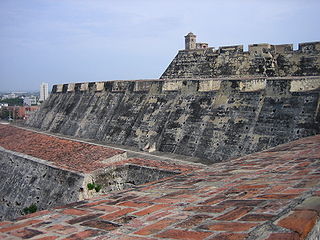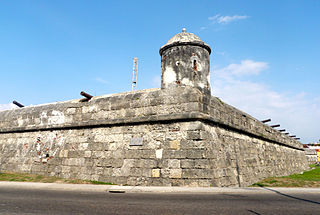
Cartagena, known since the colonial era as Cartagena de Indias, is a city and one of the major ports on the northern coast of Colombia in the Caribbean Coast Region, bordering the Caribbean sea. Cartagena's past role as a link in the route to West Indies provides it with important historical value for world exploration and preservation of heritage from the great commercial maritime routes. As a former Spanish colony, it was a key port for the export of Bolivian silver to Spain and for the import of enslaved Africans under the asiento system. It was defensible against pirate attacks in the Caribbean. The city's strategic location between the Magdalena and Sinú Rivers also gave it easy access to the interior of New Granada and made it a main port for trade between Spain and its overseas empire, establishing its importance by the early 1540s.

Las Bóvedas are a structure in the Old City of Cartagena in Colombia, attached to the walls. The Caribbean Sea is visible from the top of the structure. They were built as dungeons. They are located between the forts of Santa Clara and Santa Catalina.

Battista Antonelli (1547–1616) was a military engineer from a prestigious Italian family of military engineers in the service of the Habsburg monarchs of Austria and Spain.

El radar was a Colombian current affairs programme broadcast on weeknights at 23:00 on Caracol TV.

Cartagena Province, also called Gobierno de Cartagena during the Spanish imperial era, was an administrative and territorial division of New Granada in the Viceroyalty of Peru. It was originally organized on February 16, 1533 as a captaincy general from the central portion of the Province of Tierra Firme. In 1717, King Philip V of Spain issued a royal decree creating the Viceroyalty of New Granada, by which the province was added to the latter.
Melchor de Navarrete y Bujanda (1693–1761) was a Spanish soldier and administrator who served as governor of Cartagena de Indias, from 1739 to 1742; of Spanish Florida from 1749 to 1752; and of Yucatán, from 1754 to 1758. He was linked to several cases of corruption in Cartagena.

The Castillo San Felipe de Barajas is a fortress in the city of Cartagena, Colombia. The castle was built in 1536 and is located on the Hill of San Lázaro in a strategic location, dominating approaches to the city by land or sea. It was originally known as the Castillo de San Lázaro. It was built by African slave labor under Spanish supervision during the colonial era. The fortress was involved in several battles between the late 17th to early 19th centuries between European powers.

The Order of Saint Mary of Spain, also known as the Order of the Star, was a Spanish military order concentrating in naval activity created by Alfonso X of Castile, King of León and Castile in 1270.
Francisco de Murga y Ortiz de Orué was Spanish soldier and engineer who became Governor and Captain-General of Cartagena. He was governor of Marmora in Africa when he was appointed to fortify the plaza of Cartagena. He was a knight of Order of Santiago. He died in 1636.
Ñu, also known as José Carlos Molina-Ñu, are a Spanish hard rock band formed in 1974 in Madrid. Their music style, often described as medieval rock, has medieval music, celtic rock and heavy metal influences. The band have experienced multiple line-up changes, with vocalist José Carlos Molina being the only constant presence in the band through the years. The flute predominance in their sound has been compared with Jethro Tull's style, but playing a way heavier sound they are in fact a predecessor of folk metal. As time went by, their style tended to be less folk and more heavy. Their lyrics usually are about medieval castles, riders, villains and heroes.
The following is a timeline of the history of the city of Cartagena de Indias, Colombia.

Jorge Augusto Gamboa Mendoza is a Colombian anthropologist and historian. He has been contributing on the knowledge of hispanic and pre-hispanic territories of what is now Colombia, especially the Muisca. Jorge Gamboa speaks Spanish and French.
Don Sancho Jimeno de Orozco y Urnieta (1640–1707) was a Spanish military officer, nobleman, landowner and colonial administrator who served as the governor of Cartagena from 1693 to 1695. He was lord of the Castle of San Luis on the island of Tierra Bomba, a fort that he defended against French attackers during the raid on Cartagena de Indias in 1697. After the incumbent governor of Cartegena, Don Diego de los Rios, handed over the city to the French during the raid, Urnieta was called to govern Cartagena between 1698 and 1699.

The Castle of San Luis de Bocachica, also called Fort St. Louis, was a military fortress that defended Cartagena, Colombia. The Spanish built it in the 17th century. After it suffered war damage in the 18th century, they erected a new coastal fortification, the Castle of San Fernando on the same site.

Pedro Ruíz Corredor was a Spanish conquistador who participated in the Spanish conquest of the Muisca. He searched for El Dorado, returned to Spain, was sent back to the new world, helped consolidate newly conquered Peru for Spain, retired to his fiefdom to raise a family, and lived to a ripe old age.

The Puerta del Reloj, Torre del Reloj or Boca del Puente is the main city gate of the historic center of Cartagena de Indias, in Colombia and the original entrance of the fortified city. It is located between the squares Plaza de Independencia and Plaza de los Coches. The name "Puerta del Reloj" responds to the clock with which it was crowned at the beginning of the 18th century. While the name of Boca del Puente is due to the fact that during the colonial period, a drawbridge was raised at the foot of the channel of San Anastasio, which linked the walled city to the legendary Getsemaní neighborhood. In addition the bridge served like defense of the city, since in case of enemy attack, this one was raised to prevent the access of buccaneers and pirates.

The Baluarte de San Ignacio is a bastion located in Cartagena de Indias, in Colombia. This bastion, originally called the Bastión de los Moros, is located on the side of the House of the Jesuits and is the work of Cristóbal de Roda. It is part of the extensive fortifications built by the Spanish to defend Cartagena de Indias.

The Baluarte de Santo Domingo is a bastion located in Cartagena de Indias, in Colombia. The bastion of Santo Domingo has a particular importance, since it is the origin of the construction of the city walls of Cartagena de Indias in the early 17th century. This work of fortification was conceived around 1602 by the engineer Battista Antonelli and his nephew Cristóbal de Roda, also engineer, who decided to build it on the avenue through which the pirate Francis Drake had penetrated, in 1586.

Ruby Rumié is a Colombian artist. She studied at the School of Fine Arts of Cartagena de Indias and the David Manzur Academy in Bogotá. She has exhibited around the world in places such as Colombia, Chile, the United States of America and France.

The Iglesia de Santo Toribio de Mogrovejo is a Catholic church located in the historic center of Cartagena de Indias, in Bolívar Department, Colombia, specifically in the northwestern corner of Plaza Fernández de Madrid, at the intersection of Calle Curato and Calle del Sargento Mayor, in Barrio San Diego. Its construction began in 1666, becoming the last church in the city to be built during the colonial period, and suspended at the stage of foundation construction, it was restarted in 1730 and completed in 1732. Due to its historical value, it was declared a national monument in 1995 along with other buildings in the city.
































